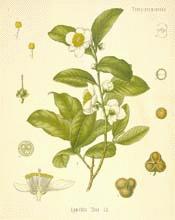

|
Tea
(Camellia thea LINK.)
|
Tea
Botanical: Camellia thea (LINK.)
Family: N.O. Camelliaceae
---Synonyms---Thea sinensis (Sims). Thea Veridis. Thea bohea. Thea stricta Jassamica. Camellia theifera (Griff.).
---Part Used---Dried leaf.
---Habitat---Assam; cultivated in Ceylon, Japan, Java, and elsewhere where climate allows.
---Description---A small evergreen shrub cultivated to a height of 7 to 8 feet, but growing wild up to 30 feet high, much branched. Bark rough, grey. Leaves dark green, lanceolate or elliptical, on short stalks, blunt at apex, base tapering, margins shortly serrate, young leaves hairy, older leaves glabrous. Flowers solitary or two or three together on short branchlets in the leaf axils, somewhat drooping, on short stalks with a few small bracts, 1 to 1 1/2 inches wide; sepals five, imbricate, slightly united below, ovate or rounded, blunt smooth, persistent; petals usually five or up to nine, unequal, strongly rounded, concave, spreading, white, caducous; stamens indefinite, adherent to petals at base in two rows, filaments fiexuose, half the length of petals; anthers large, versatile; ovary small, free, conical, downy, threecelled with three or four pendulous ovules in each cell; styles three distinct or combined at base, slender simple stigmas. Fruit a smooth, flattened, rounded, trigonous three-celled capsule; seed solitary in each cell; size of a small nut.
It was formerly supposed that black and green tea were the produce of distinct plants, but they are both prepared from the same plant. Green tea is prepared by exposing the gathered leaves to the air until superfluous moisture is eliminated, when they are roasted over a brisk wood fire and continually stirred until they become moist and flaccid; after this they pass to the rolling table, and are rolled into balls and subjected to pressure which twists them and gets rid of the moisture; they are then shaken out on flat trays, again roasted over a slow and steady charcoal fire, and kept in rapid motion for an hour to an hour and a half, till they assume a dullish green colour. After this they are winnowed, screened, and graded into different varieties. With black tea, the gathered leaves are exposed to the air for a longer period, then gathered up and tossed until soft and flaccid, and after further exposure, roasted in an iron pan for about five minutes. After rolling and pressing, they are shaken out, exposed to the outer air for some hours, re-roasted for three or four minutes, rerolled, spread out in baskets and exposed to the heat of a charcoal fire for five or six minutes and then rolled for the third time and again heated, and finally dried in baskets over charcoal fires, from which process they become black in colour. China is the great tea-producing country, over four million acres of ground being devoted to its cultivation. In India also it is a very important product.
[Top]
---Constituents---Caffeine (theine), tannin (10 to 20 per cent gallotannic acid), boheic acid, volatile oil, aqueous extract, protein wax, resin, ash and theophylline.
---Medicinal Action and Uses---Stimulant, astringent. It exerts a decided influence over the nervous system, generally evinced by a feeling of comfort and exhilaration; it also causes unnatural wakefulness when taken in quantity. Taken moderately by healthy individuals it is harmless, but in excessive quantities it will produce unpleasant nervous and dyspeptic symptoms, the green variety being decidedly the more injurious. Tea is rarely used as a medicine, but, the infusion is useful to relieve neuralgic headaches.
[Top]
Common Name Index
A MODERN HERBAL Home Page
Bear in mind "A Modern Herbal" was written with the conventional wisdom of the early 1900's. This should be taken into account as some of the information may now be considered inaccurate, or not in accordance with modern medicine.
© Copyright Protected 1995-2004 botanical.com

|

